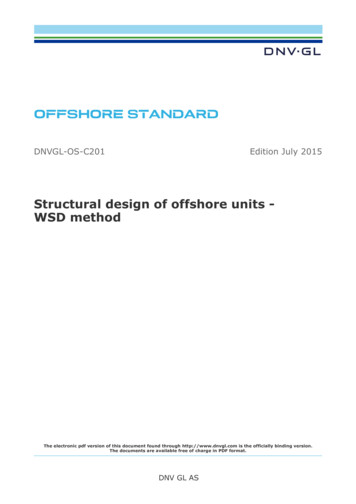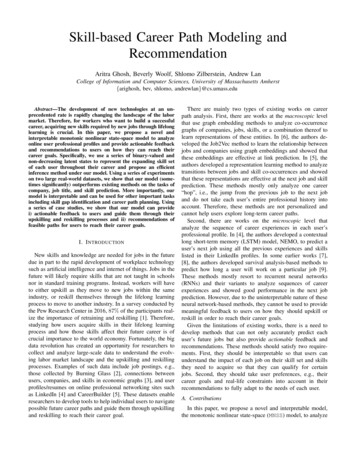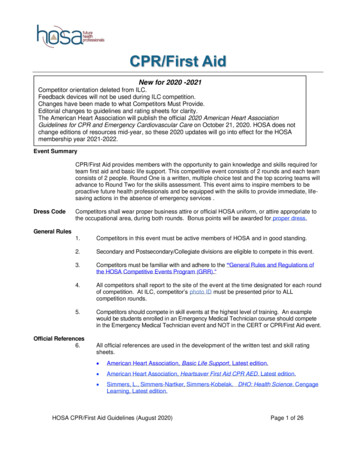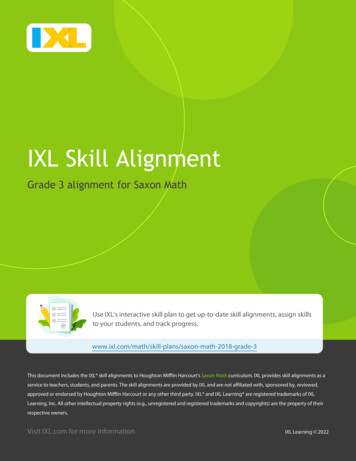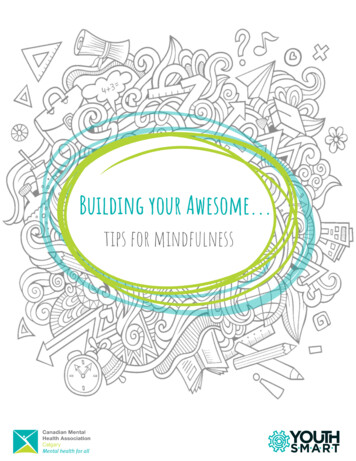![The Work Skill Development [WSD] Framework: Work- Ready Competencies .](/img/30/bandaranaikeimelt2017paper.jpg)
Transcription
I-MELT, 11-13 December 2017The Work Skill Development [WSD] Framework:Work- ready competencies for Today and TomorrowSue Bandaranaike11Collegeof Science and Engineering, James Cook UniversityCorresponding author email address: suniti.bandaranaike@jcu.edu.auA peer reviewed short paper for a presentation at the International conference on Models of EngagedLearning and Teaching (I-MELT), 11-13 December 2017. Available from www.imelt.edu.auAbstractThe Work Skill Development [WSD] framework is a learning and teaching model applied in thecontext of Work Integrated Learning [WIL] to facilitate an understanding of a placement role,resource utilisation, planning and management, lifelong learning, problem solving and criticalthinking, and communication in the workplace. It attempts to narrow the gap between the triadpartnership of placement students, educators and employers. The primary focus of the WSD is inteaching and learning work skills through reflective practice, and identifying employability pathways.The objective of this paper is (1) to outline the WSD framework and its application and contributionto contemporary teaching and learning in WIL, and (2) to predict future use. The WSD methodologyfollows a logical extension of the Research Skills Development [RSD] framework (Willison & O’Regan,2006), to work skills. The paper outlines the many-faceted applications of the WSD model - fromemployability to career management; from the cognitive focus to the affective (social, emotional,cultural intelligence), and its potential use in the changing workplace of the future.BackgroundWork Integrated Learning refers to a range of pedagogic and assessment practices from practicums,placements, internships, workplace experience or blended learning, focussed on gaining jobexperience. Patrick et al. (2008) define WIL as “an umbrella term used for a range of approaches andstrategies that integrate theory with the practice of work within a purposefully designedcurriculum”. In this paper, the term ‘Work Integrated Learning’ is used generically to identify alltypes of student traineeships that integrate academic learning with applications to the workplace.1
I-MELT, 11-13 December 2017For a long time, one of the major criticisms of WIL teaching was the lack of connectivity in the triad students, educators, and employers - and the lack of formative assessment and feedback (Atkins,1999). The WSD fills this gap in that it provides a flexible tool for assessment, and contributes to WILpedagogy.Employability frameworks in WIL to date are associated with generic and specific competencies(Core Skills for Work developmental framework, 2013; Australian Qualifications Framework 2013;DEEWR, 2012; van der Heijden & van der Heijden, 2006), qualifications (Hillage & Pollard, 1998),preparedness for work, career development and teamwork (Bradshaw, 1989; Riebe et al., 2010), andcritical reflection (Harvey, 2005; van Woerkom et al., 2002).Developing work skills is an enterprise separate from, and unrelated to, the delivery of courseworkand assessment in an undergraduate degree. Employers often refer to the mismatch betweenuniversity teaching and practice in the workplace. While the transition from tertiary studies to theworkplace requires much adjustment, it can be stressful to the student and the employer whenexpectations are not met (Bandaranaike & Willison, 2010).Initially designed for use in the cross-disciplinary Faculty of Science and Engineering at James CookUniversity, Australia, the WSD lends itself to flexibility in use. The objective of this paper is to outlinethe WSD framework, its multifaceted applications and contributions to contemporary WIL research,and its adaptation to ongoing changes in the workplace. The paper will first discuss the methodologyof the WSD framework and then discuss its multiple applications.MethodologyThe WSD is a sister framework to the RSD, exploring the connection between research skilldevelopment and work skill development. Both frameworks use similar cognitive and affective skillsets and measure levels of autonomy over time. The WSD is invaluable as a tool to facilitate thetransition from university to the workplace. Given the documented research gap in mastery of workskill competencies (Patrick et al., 2008), the WSD provides informed strategies to fill the gaps andaccordingly assist students.2
I-MELT, 11-13 December 2017While the WSD framework is based on the RSD methodology (Willison & O’Regan, 2006), it wasmapped (Bandaranaike & Willison, 2009) using a combination of graduate attributes (Graduateattributes in Australian Universities, 2010), Australian government employability skills (DEST, 2006)and Bloom’s taxonomy (Bloom et al., 1956). Subsequently, the WSD framework was revised in 2016(Bandaranaike & Willison, 2009/2016) using The Australian Blueprint for Career Development(MCEECDYA, 2010) to focus further on emotional, social, and cultural intelligence in workplacetraining.The WSD articulates six work skills facets – Initiative, Resources, Lifelong Learning, Management,Problem Solving, and Communication - and maps the level of student autonomy using five definedLevels - Prescribed Direction, Bounded Direction, Scaffolded Direction, Self-Initiated Direction andOpen Direction as illustrated in Table 1.This paper articulates the many-faceted applications of the WSD in a variety of contexts, fromplacements [WIL], to career development, to professional development, to in-course assessment.3
I-MELT, 11-13 December 2017 Table 1: Work Skill Development Framework4
I-MELT, 11-13 December 2017The WSD framework has been trialled successfully in a multidisciplinary context at James CookUniversity, Australia since 2009. Its aim was to provide a base for teaching and assessing WILstudents and to contribute to WIL pedagogy. Students are encouraged to engage in reflectivepractices to understand and apply the six WSD comprehensive work skills during their workplacement. In addition, an interview module at the end of the placement encourages furtherreflections on their placements and concludes with feedback to the student.Some examples of teaching and learning outcomes of the WSD are:1. Self-assessment of work skills in Pre and Post placements2. Educator assessment of work skills3. Employer perceptions, attitudes and assessment of placement students4. Reflections on personal learning outcomes from the placement5. Assessing strengths and weaknesses in specific work skills6. Preparation for job interviews, including addressing selection criteria using WSD skills7. Building self-confidence and developing communication skills8. Being aware of challenges, limitations and strengths in the workplace.Students apply critical reflective thinking to elucidate their understanding and practice of work skillsduring a placement. Assessment modules include a Placement Proposal, Progress Report, ReflectiveJournal, Essay and Interviews. The interview component comprises closed and open-endedquestions; Likert scale statements are used to document pre and post placement positioning on alinear scale of Learner Autonomy.The quality of WIL is independent of the quality of the experience itself, since most often the studentis unable to control the choice of his/her placement. However, the ability of the student to applycritical reflective practice to WIL enables new learnings (Kathpalia and Heath, 2008; Sykes and Dean,2012). To facilitate critical reflection, an online base was designed to self-appraise studentperformance - Pre Placement [commencement], In Placement [half way through] and PostPlacement [completion] - and compile a personalised employability skill profile of a student’s WILjourney (Torres, Bandaranaike & Yates, 2014).Empowering placement students to develop workplace autonomy through critical self-reflection ispivotal to the transition from university to employability (Bandaranaike & Willison, 2017). Student5
I-MELT, 11-13 December 2017awareness of appropriate levels of autonomy (WSD) correctly aspired to in the workplace isimportant to the transition from university.DiscussionOne of the unique properties of the WSD is, using the Levels of Autonomy, its ability to plot anindividual’s progress over time within a placement, such as Pre (beginning) and Post (completion)placement performances using a linear scale (The Levels of Autonomy). These perceived changes arerelevant to individually profile a student’s strengths and weaknesses within a placement. Thismethodology was used successfully to profile an average for a select sample group of workplacestudents, and assess specific teaching and learning outcomes (Bandaranaike & Willison, 2010). Thismethodology was replicated at the Universidad de Guadalajara in the Faculty of Management inMexico. Similarities and differences were compared with a previous Australian study (Quijano &Bandaranaike, 2017). The original survey tool was translated to Spanish in this research.Other international users of the WSD framework for similar outcomes are the Suranaree Universityof Technology, Bangkok, where the WSD framework and the Interview modules were translated intoThai. The framework is also in use at the Cape Peninsula University of Technology, South Africa. Thedata collected is for international comparisons of pre and post placement positioning of studentsand cross-tabulations to identify factors contributing to a change (or absence of change), in theLevels of Autonomy.The School of Dentistry, Adelaide University Australia, compiled a new framework to mirror WSD intheir clinical skills. The paper discusses the framing and planned implementation of an applied modelof reflective practice, the Clinical Reflective Skills (CRS) framework for undergraduates in clinicalplacements (Bandaranaike, Snelling, Karanicolas, & Willison, 2012). The value of this framework liesin its ability to measure the more holistic aspects of developing the professional skills required by allhealth professionals through reflective practice.Other researchers have successfully used components of the WSD to WIL modules within a coursesuch as at Central Queensland University, Australia (Sullivan & Bandaranaike, 2017). Preliminarydiscussions in using the WSD for Teacher Education are also in place at the University of theSunshine Coast, Australia (workshop and personal communication, D. Heck, 2017). While the entire6
I-MELT, 11-13 December 2017potential of the WSD has not yet been unleashed, the above are a few applications in WIL teachingand learning.The competition to have graduates ready for the workforce has resulted in educators concentratingmainly on teaching cognitive skills (Krahn, Lowe & Lehman, 2002). Ferns & Zegwaard (2014, p.186)state that traditional assessment methodologies focus on knowledge acquisition rather thanproficiency in employment capabilities. From the employer’s point of view, social skills andpersonality type are more important than degree qualification (Archer and Davison, 2008).Work-readiness of students relates to the understanding of both the cognitive and the affectivedomains in the workplace (Bandaranaike & Willison, 2015a). Affective skills are based on emotionaland social intelligence (Goleman, 1998; Salovey and Mayer, 1990). The context of using social andemotional skills in the workplace is discussed in Bandaranaike & Willison, (2015b). A Cross CulturalCompetency (CCC) framework (Bandaranaike & Willison, 2016) to develop globally proficientprofessionals (Bandaranaike & Gurtner, 2016) has also been developed as an extension of WSD.Career management competencies impact on long-term career success and greater employeemobility (Jackson & Wilton, 2016). In this context, a modified version of the WSD, the Allied HealthCareer Development Framework (AHCD), has been developed for practicing health professionals tofacilitate the successful transition from being a novice to a professional (Bandaranaike & Kimmerly,2014). The model monitors professional growth, uses reflective practice and peer coaching, andhelps create a more goal-oriented employee.When considering the future of the 21st century WIL, students must train for a more futuristicworkplace (Smith & Anderson, 2015) where, for example, artificial intelligence will replace humansin some jobs (CBS News, 2015). Using the WSD model, this adjustment is possible in the use ofTechnology & Resources. For example, it may be essential to create software and hardware to getcomputers to do things that would be considered ‘intelligent’ as when people did them, or in theManagement and Planning skill facet, to allocate the more routine jobs to robots. Even thoughresearch in Artificial Intelligence (AI) is still in its infancy, it is important that WIL teaching andlearning be aware of these changes (Kaplan, 2015).7
I-MELT, 11-13 December 2017ConclusionThe WSD enables both students and administrators to engage in reflective practice on the whole WILprocess. While this research has provided valuable feedback in bridging the gap between learningoutcomes and practice-based assessment, more long-term data collection is required for a betterunderstanding of student performance in the workplace and for supporting the WSD as amanagement tool in Work Integrated Learning.In summary, as a Teaching & Learning Model, the WSD oServes the triad partnership of students, educators and employers to bridge the gap andmake meaningful connections.oProvides students with an opportunity to access employability pathways, career training,networking, and feedback, and to assess progress over time.oFacilitates assessment and feedback from both the educator and the employer.oUses reflective practice in unlocking the key workplace skills and practices.oMonitors progress in professional development, career management, resume writing, jobinterview preparation, addressing selection criteria etc.oAids in the integration of future social, economic and technological changes in the workplace, and in WIL teaching & learning.oProvides employer involvement with undergraduates through placements, mentoring, andcontribution to business objectives.The success of WSD is the underpinning methodology used in the design, delivery and assessment ofWIL students.Connectivity is the common thread for jobs of the future. The question is “how well do WIL modelsadjust to change if they are to create the new human capital conduits required for the future?” As anengaged teaching and learning model, the WSD framework has demonstrated its flexibility in useacross several disciplines and its allied use in career development, job seeking, resume writing and atinterviews. The next stage in the WSD framework application will be its adaptation to the projectedAI changes of the 21st century.8
I-MELT, 11-13 December 2017ReferencesAustralian Qualifications Framework [AQF], Second Edition (2013). Retrieved 05/AQF-2nd-Edition-January-2013.pdfAnderson, L. W., Krathwohl, D. R., Airasian, P. W., Cruikshank, K. A., Mayer, R. E., Pintrich, P. R.,Raths, J., & Wittrock, M. C. (2000). A taxonomy for learning, teaching, and assessing: Arevision of Bloom's taxonomy of educational objectives. New York, NY: Pearson, Allyn &Bacon.Atkins, M.J. (1999) Oven‐ready and Self‐basting: taking stock of employability skills, Teaching inHigher Education, 4(2), 267-280, DOI: 10.1080/1356251990040208.Bandaranaike, S., & Willison, J. (2009). The Work Skill Development /frameworks/Bandaranaike, S. & Willison, J. (2010). Work Skill Development Framework: an innovativeassessment for Work Integrated Learning. In M. Campbell (Ed), Work Integrated Learning –Responding to Challenges: Proceedings of the 2010 ACEN National Conference, 1–19. Perth.Bandaranaike, S. & Willison, J. (2015a). Understanding Emotional Work-readiness in the Workplace.Proceedings of the 19th World Conference on Cooperative & Work Integrated Education.Kyoto Sangyo University, Kyoto, Japan, August 18-22.Bandaranaike, S. & Willison J. (2015b). Building capacity for work-readiness: Bridging the Cognitiveand Affective Domains. Asia-Pacific Journal of Cooperative Education, Special Issue, 16(3),223-233.Bandaranaike, S. & Willison, J. (2016). WIL 2020: A framework for cross-cultural competency in theworkplace. In M. Harvey & A. Rowe (Eds.), WIL 2020: Pushing the Boundaries. Proceedings ofthe 2016 ACEN National Conference. 42-49. Springvale South: Australian CollaborativeEducation Network Limited.Bandaranaike, S., & Willison, J. (2009/2016). The Work Skill Development /frameworks/Bandaranaike, S., & Willison J. (2017). Scaffolding Learner Autonomy in Work Integrated Learning.Proceedings of the 20th World Conference on Cooperative and Work Integrated Learning,Chiang Mai, Thailand, June 5-8.Bloom, B., Engelhardt, M.D., Furst, E.J., Hill, W.H., & Krathwohl, D.R. (1956). Taxonomy ofEducational Objective. New York: David McKay Company.Bradshaw, D. (1989). Higher education, personal qualities and employment: Teamwork. OxfordReview of Education, 15(1), 55-71.9
I-MELT, 11-13 December 2017CBS News. (2015). Will artificial intelligence overtake humans in the workforce? CBS Interactive Inc. 5Sept. 2015. Web 27 Nov. 2015.Core Skills for Work developmental framework [CSfW]. (2013). Department of Industry, Innovation,Climate Change, Science, Research and Tertiary Education and Department of Education,Employment and Work Relation. Canberra: Commonwealth of Australia.Department of Education, Employment and Workplace Relations [DEEWR]. (2012). EmployabilitySkills Framework, Stage 1, (Final report). Canberra, ACT, Australia.Department of Education, Science and Training [DEST] (2006). Employability Skills from Frameworkto Practice. Canberra: Commonwealth of Australia.Doelo, S. (2008). Measuring student reflection during engineering internships. Work IntegratedLearning (WIL): Transforming Futures, WACE Asia Pacific Conference Proceedings. 30 Sept. 3rd Oct. 2008, 9/WACE ACEN Asia Pacific Conference 2008 E-Proceedings-1.pdf?x99824.Department of Education, Science and Training [DEST] (2002). Employability skills for the future.Canberra, available: http://www.deewr.gov.au/Ferns, S., Campbell, M., & Zegwaard, K. (2014). Work Integrated Learning. In S. Ferns (Ed.), HERDSAGuide: Work integrated learning in the curriculum (pp. 1–6). Australia: Higher EducationResearch and Development Society of Australasia.Graduate attributes in Australian Universities, E-77FF-4998-9B62705AADAB0BF2/1326/appendix grad attributes.pdfGoleman, D. (1998). Working with emotional intelligence. New York, NY: Bantam Books.Harvey, L. (2001). Defining and measuring employability. Quality in Higher Education, 7(2), 97-109.Hillage, J., & Pollard, E. (1998). Employability: Developing a framework for policy analysis.Research Brief 85. London, UK: Department for Education and Employment.Jackson, D., & Wilton, N. (2016). Developing career management competencies amongundergraduates and the role of work-integrated learning. Teaching in Higher Education,21(3), 266-286.Kaplan, J. (2015). The Age of the Robot Worker Will be Worse for Men. The Atlantic. 4 Aug. 2015.Web. 27 Nov. 2015.Kathpalia, S., & Heath, C. (2008). Reflective writing: Insights into what lies beneath. RELC, 39(3), 300317.10
I-MELT, 11-13 December 2017MCEECDYA (2010). The Australian Blueprint for Career Development, prepared by Miles MorganAustralia, Commonwealth of Australia, CanberraNewton, S., & Lowe, R. (2013). Learning and teaching technical competence in the Built Environmentusing serious video game technology, Sydney Australia: Office for Learning and Teaching,60pp.Newton, S., & Lowe, R. (2015) Situational eLearning with immersive technologies, in S. Saha, Y.Zhang, S. Yazdani and A. Singh (Eds) Implementing Innovative Ideas in Structural Engineeringand Project Management, ISEC Press, pp. 3-12.Papadopoulos, T., Taylor, T., Fallshaw, E., & Zanko, M. (2011). Engaging industry: Embeddingprofessional learning in the business curriculum, ALTC Final Report. Retrieved fromwww.embeddingprofessionallearning.comPatrick, C. J., Peach, D., Pocknee, C., Webb, F., Fletcher, M., & Pretto, G. (2008). The WIL [WorkIntegrated Learning] report: A national scoping study [Australian Learning and TeachingCouncil (ALTC) Final report]. Brisbane: Queensland University of Technology. Available onlineat: www.altc.edu.au and www.acen.edu.auQuijano, P.O., & Bandaranaike, S. (2017). The Challenges of Understanding Work Skills through Preand Post Perceptions of WIL students in Mexico. Proceedings of the 20th World Conferenceon Cooperative and Work Integrated Learning, Chaing Mai, Thailand, June 5-8.Riebe, L., Roepen, D., Santarelli, B., & Marchioro, G. (2010). Teamwork: Effectively teaching anemployability skill. Education & Training, 52(6/7), 528-539.Salovey, P., & Mayer, J. D. (1990). Emotional intelligence. Imagination, Cognition and Personality,9(3), 185-21.Sykes, C., & Dean, B. (2012). A practice-based approach to student reflection in the workplace duringa Work-Integrated Learning placement. Studies in Continuing Education, 35(2), 179-192.doi:10.1080/0158037X.2012.736379Sullivan, M. & Bandaranaike, S. (2017). Challenges of the New Work Order: A Work SkillsDevelopment approach. Proceedings of the 20th World Conference on Cooperative and WorkIntegrated Learning, Chiang Mai, Thailand, June 5-8.Smith, A., & Anderson, J. (2015). AI, Robotics, and the Future of Jobs. Pew Research Center. 6 Aug.2014. Web. 30 Nov. 2015.Van der Heijde, C. M., & Van der Heijden, B. I. J. M. (2006). A competence based and multidimensional operationalization and measurement of employability. Human ResourceManagement, 45(3), 449-476.11
I-MELT, 11-13 December 2017Van Woerkom, M., Loek, N., & Nieuwenhuis, F. M. (2002). Critical reflective working behaviour: asurvey research, Journal of European Industrial Training, 26(8), 375 –383.Willison, J. (2012). When academics integrate research skill development in the curriculum. HigherEducation Research and Development, 31(6), 905 - 919Yorke, M. (2006). Employability in higher education: What it is -what it is not? Learning &Employability Series One.Retrieved s/id116 employability in higher education336.pdfWillison, J. & O’Regan, J. (2006). Research Skill Development cts/rsd12
Some examples of teaching and learning outcomes of the WSD are: 1. Self-assessment of work skills in Pre and Post placements 2. Educator assessment of work skills 3. Employer perceptions, attitudes and assessment of placement students 4. Reflections on personal learning outcomes from the placement 5.


